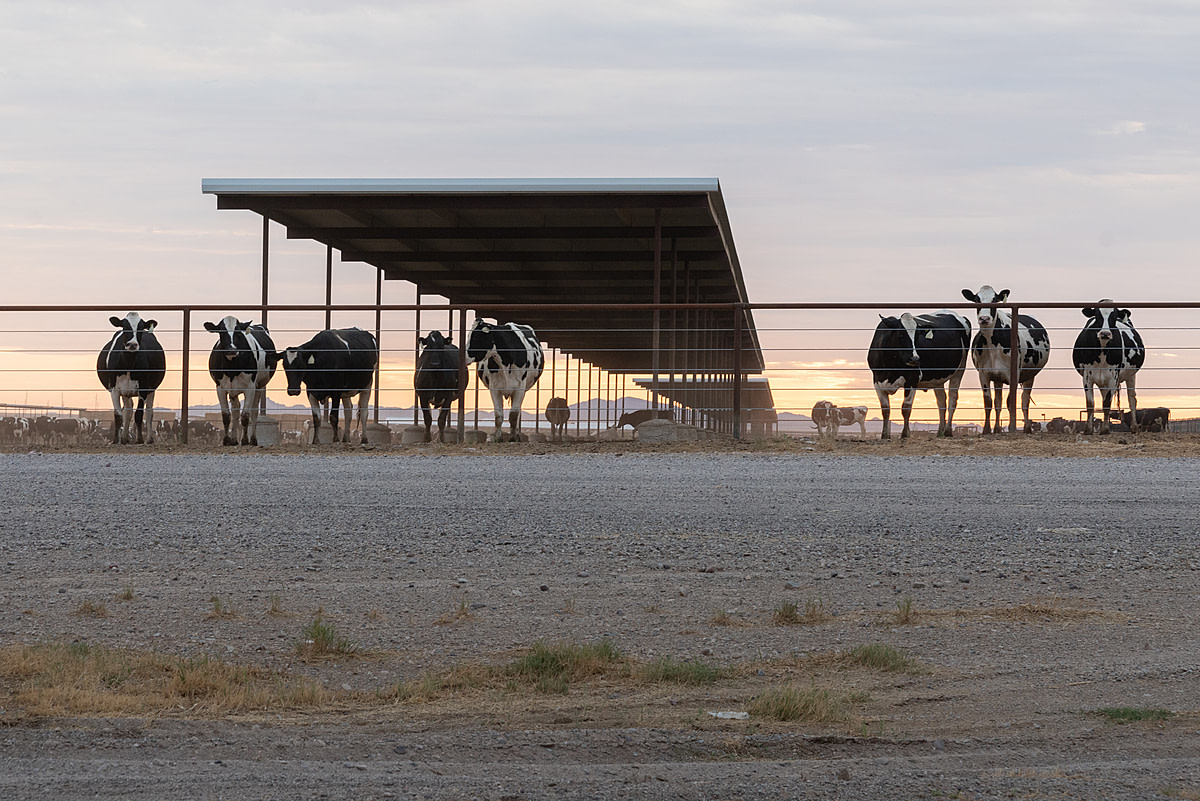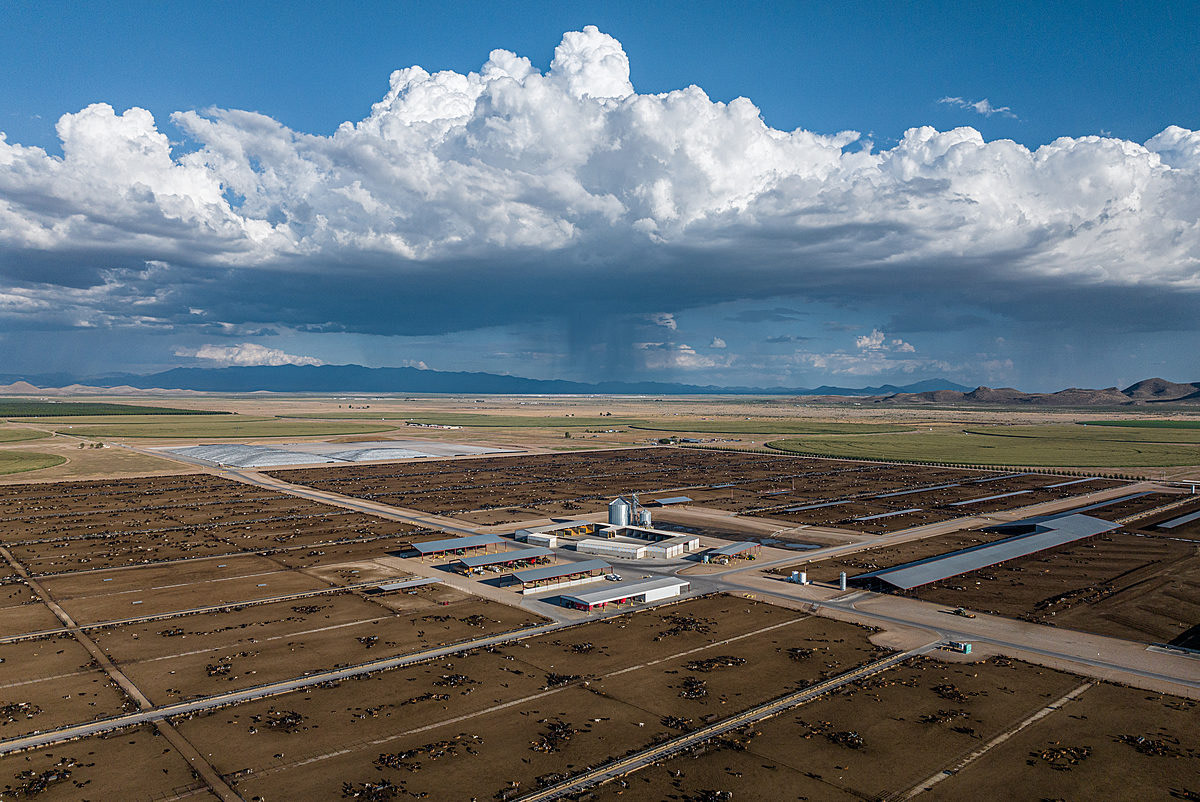Arizona’s Mega-dairies and Water Crisis
Photographer/Videographer: Ram Daya
Author: We Animals Media
Explore and download these visuals via our stock platform.
“My normal approach to assignments is to be very physically close to who or what I’m photographing. But to show the scale of the cattle and dairy industry in Arizona, it had to be done from the air. To see a calf born and immediately taken from their mother, to watch the carcass of a dead cow dumped unceremoniously next to others; these actions would be invisible from anywhere but a bird’s eye view or through deep investigative work. And that’s why these investigations are important—they make the unseen seen.” ― Ram Daya, animal photojournalist
As of 2023, Arizona has an estimated 960,000 cattle, with approximately 80 dairy farms that use 195,000 cows for milk production and hundreds of thousands more cattle living on CAFO’s and ranches throughout the state.
These corporate farms use land and groundwater to raise cattle and grow alfalfa and forage feed for cattle both locally and farther afield. Residents complain that these “mega-dairies” are drying up wells and aquifers and causing water scarcity in a state that is already experiencing a groundwater crisis.
An investigation into the expansion of Minnesota-based dairy company Riverview, LLP claims this to be the main cause of residents’ wells running dry, stating, “local industry and resources have been monopolized by a deep-pocketed entity. The groundwater is being depleted and polluted. Incessant traffic, dust, lights and the stench cause home values to plummet and strain the emotional ties locals have to the places they call home.”
According to the Arizona Department of Water Resources, Arizona’s farmed animal operations use 100 percent groundwater. The local community continues to plead with officials to enact groundwater pumping restrictions, or place a moratorium on large-scale animal farming operations in the region.
Turkey Creek Dairy, owned by Riverview, LLP is one of the state’s most extensive dairy operations, with cattle yards able to accommodate up to 130,000 heifers and dairy cows, and 17,000 white plastic hutches for calves. Riverview began as a Midwestern family farm, eventually expanding into an investor-funded corporation. The corporation’s water use has come under scrutiny for reputedly accelerating the aquifer’s depletion, having drilled more than 80 wells in the Willcox Basin aquifer, several more than 300 metres (1,000 feet) deep.
An aerial view of cows in barren dirt pens and the numerous other structures of a massive dairy farm stretching across a desert landscape. Paloma Dairy, Gila Bend, Arizona, USA, 2023. Ram Daya / We Animals Media
Five Rivers, the parent company of the McElhaney Feedyard, self-proclaims to be the largest cattle feeder in the world. The enterprise owns 13 feedlots in six different states, which can house 865,000 cattle at any one time between them. Of all the Arizona facilities our photojournalist visited, this feedlot was the most striking in its vastness.
Thousands of cattle occupy long rows of barren dirt enclosures at a sprawling feedlot. This facility holds up to 115,000 cattle. The visible cattle appear to be dairy breeds. McElhaney Feedyard, Wellton, Arizona, USA, 2023. Ram Daya / We Animals Media
As an industry that exploits a staggering number of sentient beings for investor profits, the problems with dairy farming extend beyond its use of scarce water resources.
The bloated bodies of several dead and decomposing cattle, some appearing to be dairy breeds, lie spread out in the sun in the yard of a massive feedlot. This particular facility holds up to 115,000 cattle. McElhaney Feedyard, Wellton, Arizona, USA, 2023. Ram Daya / We Animals Media
Thousands of cattle occupy rows of barren dirt enclosures at a sprawling feedlot. This facility holds up to 115,000 cattle. The visible cattle appear to be primarily dairy breeds. McElhaney Feedyard, Wellton, Arizona, USA, 2023. Ram Daya / We Animals Media
Summer temperatures in Arizona can exceed 43 degrees Celsius (110 degrees Fahrenheit). Though shade structures are provided, cattle are at high risk for heat stress and in extreme cases, these conditions can lead to death.
The splayed and bloated bodies of dead cattle, some appearing to be dairy breeds, lie decomposing in the yard of a massive feedlot. This particular facility holds up to 115,000 cattle. McElhaney Feedyard, Wellton, Arizona, USA, 2023. Ram Daya / We Animals Media
In July 2023, Arizona experienced a record-breaking mega heat wave with 22 straight days of such extreme temperatures. As summer heat waves driven by climate change become more common, farmed animals are at higher risk for death due to heat-related causes.
Cows on a large dairy farm avoid the desert sun, lying crowded together in a small patch of shade provided by a sun shelter. Butterfield Dairy, Buckeye, Arizona, USA, 2023. Ram Daya / We Animals Media
Similarly to other industrial dairy operations around the globe, calves on Riverview’s sites are immediately separated from their mothers at birth and kept in hutches for up to ninety days. Farms sell male calves and females slated for the beef market at a few days of age. The other females grow up to be used for milk production in Arizona, or are shipped to company-owned dairy farms in other states.
Milk dispenser trucks drive between the incalculable number of calf hutches in a massive dairy farm’s yard. Turkey Creek Dairy, Pearce, Arizona, USA, 2023. Ram Daya / We Animals Media
Ram Daya’s visuals offer a unique bird’s eye view of Arizona’s extensive dairy industry, highlighting its alarming scale–one that is otherwise difficult to imagine.
Data sources: USDA/NASS / Making Action Possible for Southern Arizona / High Country News / The Guardian / AP News / AP News
Images and video footage by Ram Daya.
Explore and download visuals from this assignment via our stock platform and help tell these underreported stories.
Donate today and help us continue to produce compelling global investigations into industrial animal farming.
More like this from We Animals Media:
Assignment: Inside Canada’s Cattle Feedlots
by We Animals Media | Jul 19, 2022
Investigation: Inside Vermont’s Dairy Industry
by We Animals Media | Feb 26, 2022
We Animals Media: An Untold Story of Dairy Production
by Jo-Anne McArthur | Jun 20, 2019








